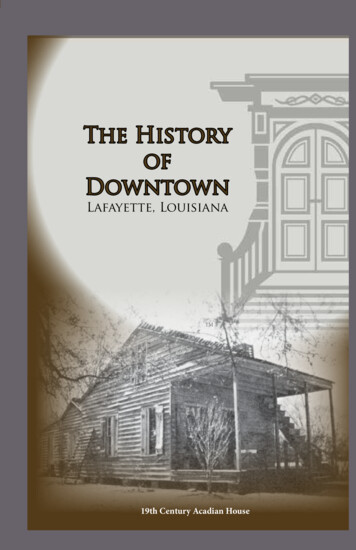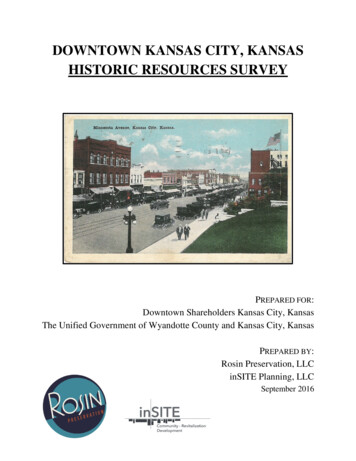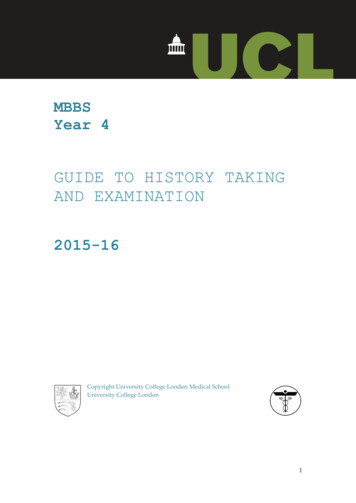
Transcription
The HistoryofDowntownLafayette, LouisianaTM19th Century Acadian House
Poché Prouet Associates, Ltd.Renaissance MarketThomas R. Hightower, Jr.A Professional Law CorporationWe are grateful each and every time you
Joel BreauxBroDesignPoupart Bakery Inc.Theriot Design Group, LLC
History of the Development of LafayetteDrawing is circa 1918, by J. N. Marchand.It was a gift to The Historic New Orleans Collection by Mary Alma Riess. 2008.0242.3.3The Early Years - A BackgroundThe first European explorers to visit Louisiana camein 1528 when a Spanish expedition led by Panfilo deNarváez located the mouth of the Mississippi River.The French explorer Robert Cavelier de La Salle named theregion Louisiana in 1682 to honor France’s King Louis XIV. Thefirst permanent settlement, Fort Maurepas (at what is now OceanSprings, Mississippi, near Biloxi), was founded in 1699 by PierrePageSouciBuildingLe Moyne d’Iberville, a French military officerSansfromCanada.
Prior to November 1762, when France ceded territory rightsof Louisiana to Spain, the Attakapas Region was mostlyinhabited by Native Americans of the Attakapa-Ishak andChitimacha tribes. There were only a sparse number oftraders, ranchers and smugglers of European descent.Catholic Church records indicate that Acadians arrivedin New Orleans in early 1764. Their family names wereCormier, Landry, Poirier, Olivier, Brazier, Richard, Deville,Degoutin, Coutrie, and others. Some moved on to findfertile land in the Attakapas region and beyond. Otherssettled along the Mississippi River west of New Orleans.In early 1765, there were 4 families of Acadians, a total of21 people, who settled on the western Attakapas frontier,and shortly thereafter 37 more Acadians arrived. Theirleaders names were Joseph “dit Beausoleil” Broussard,Joseph Guilbeau,Jean Dugas, Olivier Thibodeau, JeanBaptiste Broussard, Pierre Arseneau, and Victor Broussard.Acadians settled mainly along the Bayou Teche betweenSaint Martinville and Breaux Bridge. Many of these Acadiansmoved after the Yellow Fever epidemic in June 1765. InMarch of 1766, 37 Acadians settled nearpresent-dayBroussard, Louisiana. They called it Cote Gelee, meaningfrozen hill, because that winter was unseasonably cold.PageSans Souci Building“Breaking Prairie” 1855 Image from Harper’s Magazine
Initial Acadian settlements in the Attakapas region were locatedclose to the Lafayette Regional Airport between the city of Lafayetteand the town of Broussard along the west bank of the Bayou Tortue.Throughout the late 18th century, traveling around theundeveloped Attakapas region was limited to waterways andrough trails. Since the Bayou Vermilion through Lafayette atthe time was full of fallen trees and other natural obstacles,it was not navigable by any vessel large enough to carry sizablecargo. The Pinhook Bridge area became a place where tradersunloaded their boats and waited local transportation by horseand travois, and later wagons. They delivered to nearby ranchesand traded with the local Native Americans and fur trappers.1925 Photo of Vermilion Bayou North of the Pinhook BridgePhoto is courtesy of Louis J. Perret, Lafayette Parish Clerk of CourtsAccording to the book, “Louisiana Place Names of Indian Origin:A Collection of Words” by William A Read, the name Pinhookis believed to have been derived from the Chocktaw word,“Pinashuk” meaning Basswood or Linden tree. It is said that therewas a large Linden grove along the Vermilion Bayou in presentday Bendel Gardens Subdivision. The Linden tree provided NativeAmericans with useful medicine and was also used as a perfume.PageSans Souci Building
1921 Photo of Vermilion Bayou’s Pinhook BridgePhoto is courtesy of Louis J. Perret, Lafayette Parish Clerk of CourtsOn the Old Spanish Trail, at Pinhook Bridge where it crosses theBayou Vermilion, there was a small rustic building serving as aninn and restaurant. According to Harry Lewis Griffen’s book,“The Attakapas Country”, The Inn was a gathering place fortransporting materials and goods from the Bayou Vermilion ontolocal hired wagons for delivery at nearby plantations. The locationof that inn is believed to be at present-day Café Vermilionville.Circa 1835 Café Vermilionville, National Register Historic Property
Both the French and Spanish officials granted lands freelyalong the bayous Carencro and Vermilion. In 1800, NapoleonBonaparte re-acquired the territory of Louisiana from Spainbefore selling the territory to the United States in 1803.The area we know now as Lafayette Parish was a portion of theplains called the Attakapas Region. It included present-day St.Landry, St. Martin, Vermilion, Iberia and Lafayette Parishes.Depiction of Le Grand Dérangement de les Acadiens (the Great Deportation of theAcadians) in 1755, courtesy of Dudley J. Leblanc1803 Louisiana became part of US, and Americans began toimmigrate to the village of Vermilionville from the easternseaboard and southeastern states in search of inexpensive fertileland. In many cases people discovered the area by stopping ontheir journey to Texas. American families such as the Baileys theMudds and the Campbells settled in Vermilionville and broughtwith them skills and technology that encouraged urban growth.
In January of 1823, Louisiana Legislature carved Lafayette Parishfrom the western portion of Saint Martin Parish. It includedpresent-day Vermilion and Acadia Parishes, and extendedwest to the Mermentau River and south to the Gulf of Mexico.By 1820, the Population of Attakapas County numbered over12,000 people. One of the several large and increasinglyaffluent families in the area was that of Jean Mouton.Mouton’s father, Salvador, had come to St. James Parishas an exiled Acadian.Around 1760, as a young man,Jean came to the Attakapas country and settled northof Pinhook Bridge on the banks of the Vermilion.Jean Mouton’s Development - 1824 VermilionvilleJean Mouton found there was an increasing demand for spacein the seat of Lafayette Parish. He created from his property, anew development adjacent to the church and designed arounda Court House Square. The new development consistedof 156 lots, each measuring 96 x 140 feet, with dirt roadsaligned in a north-south grid and named for US Presidents.
By the 1830s Lafayette Parish had developed a uniqueprofusion of small plantations, which helped to make thingsfavorable for the development of an urban middle class.On smaller plantations it was not feasible to employ thenecessary skilled laborers such as blacksmiths, wheelwrights,and carpenters on a full time basis. Therefore, the needfor merchants, skilled artisans and craftsmen grew.Jean Mouton’s circa 1800 Maison Dimanche (Sunday House) used by the family beforeand after Mass at nearby Saint John the Evangelist Catholic ChurchBy 1835, Americans immigrating to the area increased thepopulation in Vermilionville, and as such, the Police Jurybegan to build roads and also new courthouse building.An American, Dr.of the best knownin partnership withnewspaper, whichFrancisdoctorsErastelaterSterlingin town,Mouton,becameMudd became oneand William Baileyoperated the villagetoday’s “Advertiser”.
The growth of the middle class in Vermilionville was acceleratedby the influx of immigrants from Germany, France and Irelandthrough the Port of New Orleans between 1840 and 1850.Pierre Gerac arrived from France and set up the Gerac Cotton Ginat Vermilionville. Michel Eloi Girard born in France became aprominent attorney in Vermilionville. Jewish merchants such asthe Plonskeys, Levys, Falks, and Wises found Lafayette to be a warmand friendly place, and being familiar with the French languageand culture, they found it easy to establish mercantile outlets.Town of Vermilionville had a unique atmosphere for the area. Itwas ripe with opportunity for middle class material advancementdue to the increasing need for products services and skills.In 1884, the town of Vermilionville changed its name to Lafayette,Louisiana. It had grown to 2,106 people based on the Census of 1890,which was more than double the population of the previous tenyears. There are a few buildings from that time that still exist today.William Brandt House – 1820 (built as overseer’s house)Alexandre Mouton House, c. 1825 (expanded to residence)Café Vermilionville, c. 1835Sans Souci, c. 1840 (operated as an inn)Dr. J.D. Trahan House, c. 1869Lafayette Hardware Store, c. 1880Maison Revillon, c. 1880Caffery House, c. 1886Caillouet House, c. 1886Grado Building, c. 1890 (built as a residence)Garfield House, c. 1890Old City Hall, 1898
WiveUnJohn M.ShawunitedS ta t e sCourthousetyAvePPublicLibrarySt982WtPa r ACraftsguild4eldrfiGaStLeeAve35. Caffery House54. Garfield House43. Lafayette Train DepotRosa Parks Transportation Center3Historic register retailerSt52. Evangeline HoteldS2nWW 3rd StHistoric Tour routeVermilion StPa r cPutnumCenterlower DowntownHistoric Neighborhoodtour route101W Congress StPedestrianscrossW. CongressStreethereVoorhies StPedestrians crossW. Congress Street here1. William BrandtHouseupper Downtown Historic PropertyCathedralMuseumVersailles Blvd.rsi10. Dr. J. D. TrahanHouse109. Southern BellTelephoneExchangewww.PreservingLafayette.org6. Heymann Food StoreChildren’s Museum ofAcadiana67. Maurice HeymannBuildingLafayette ScienceMuseum7S Washington Stat W. Congressue8. Old GuarantyBank BuildingBuWilliamBrantHouse614 Madison StnochaJ1ibeBRuLafayette StteqlionStnStsoefferTour beginsand ends att9rS8StnstonStJoheVinStTayloressCyp
WILLIAM BRANDT HOUSE614 Madison StreetNATIONAL REGISTER PROPERTYLocal Historic Property #56Built: circa 1870Style: Greek RevivalDesignated: March 20, 2003Greek Revival is the style of this circa 1870 structure, namedfor William Brandt, the then Notary Public and Court Recorderfor the town of Vermilionville. Mr. Brandt purchased theproperty in 1859 and remodeled it to its present look. Priorto being remodeled, the structure was built at its presentlocation as a two-room Acadian cottage. It was an overseer’sresidence on Charles Mouton’s Plantation, now a bed andbreakfast called Bois des Chênes. Experts estimate it was builtbefore 1820. Current owner and historian, Sonya LaCombBoudreaux, discovered several clues during restoration workconfirming the front of the house originally faced what is nowWest Congress Street. The current side hall entrance is theformer front gallery, or porch. Around 1880, the entire roofwas re-constructed to its present configuration, and a newfront gallery was added, creating the Greek Revival façadethat exists today. It is one of the very few surviving 19thcentury Greek Revival style structures in Lafayette Parish.
Circa 1800 Smoke HouseCirca 1825 Alexandre Mouton HouseCirca 1800 Maison DimancheALEXANDRE MOUTON HOUSELAFAYETTE MUSEUM1122 Lafayette StreetNATIONAL REGISTER PROPERTYLocal Historic Property #2Built: circa 1800Style: French ColonialDesignated: November 1, 1990Alexandre Mouton House was built by Jean Mouton, founderof Vermilionville. He was one of the first settlers of Southwest Louisiana. He owned vast amounts of property in thearea, including where Downtown Lafayette now exists. Jeandonated land for both the Lafayette Parish Courthouse aswell as Saint John the Evangelist Catholic Church. Alexandre Mouton House was first built as a one-room “Sundayhouse” or “maison Dimanche”, in French. It was used byJean and his family while they were in town, especially toattend Catholic Mass. Around 1825, the main house was expanded into a full-time residence by Jean’s son, AlexandreMouton, who served as State Representative, State Senator,and Louisiana’s 12th Governor. The building is now home toLafayette Museum; owned and maintained by “Les VingtQuatre”, a group of cultural and civic-minded ladies, whoseoriginal members saved the building from demolition in 1954.
CAFÉ VERMILIONVILLEFormerly VERMILIONVILLE INN1304 West Pinhook RoadNATIONAL REGISTER PROPERTYLocal Historic Property #13Built: circa 1835Style: Greek RevivalDesignated: February 7, 1991Café Vermilionville was built as the first inn of the area,well before the small town of Vermilionville was developed.It was the site where traders gathered, having traveled byboat to the Vermilion Bayou landing near Pinhook Bridge, totrade with both Native Americans and fur trappers. Given thefact that waterways were the chief means of transportationat the time, several businesses developed around the site.Salesmen came by boat to lodge at the inn, and the sceneincluded numerous hired horses and buggies ready to taketheir goods throughout the surrounding towns to do business. The inn became a center for commercial and socialinteraction for the area then called the Attakapas Prairie.After being restored in 1954 by Horace B. Rickey, Sr., thebuilding has served several uses. Many remember when thebuilding was “Judge Roy Beans Saloon”. Today, the building is enjoyed as one of Lafayette’s finest restaurants, andit is architecturally cherished as one of only five two-storyFrench Colonial structures remaining in Lafayette Parish.
SANS SOUCI219 East Vermilion StreetLocal Historic Property #58Built: circa 1840Style: Commercial VernacularDesignated: March 20, 2003The Sans Souci building may be the oldest commercial building surviving in Lafayette’s downtown area. While the actualconstruction date is not known, the building’s long historywithin the community is certain. Built by Richard Chargois,an early business leader in Lafayette, it remained in theChargois family until 1943. At the time of its construction,the property was located on the outskirts of Lafayette andthe building welcomed guests as the Lafayette Inn. It wasalso a carpenter’s store, a grocery market, a tinsmith shop,and housed Lafayette’s first post office and newspaper. Thismemorable wooden building is named for the Sans Souci Bookstore, opened in 1943 by the woman who established the ULLafayette campus library, Ms. Edith Garland Dupre. Today itserves as the home of Sans Souci Fine Crafts Gallery. Renovations were completed in 2001, and the structure now residesin the urban park that was built around it and shares its name.
DR. J. D. TRAHAN HOUSE814 South Washington StreetLocal Historic Property #21Built: 1869Style: French CreoleDesignated: June 6, 1992Dr. J.D. Trahan was a pharmacist for General AlfredMouton during the Civil War. Dr. Trahan and his wife, RoseAlice Larribeau, bought this property from Joseph Breauxin 1869. After studying medicine at Tulane University, Dr.Trahan returned to Lafayette and built this structure forhis new bride. Dr. Trahan’s son, Dr. Anatole Trahan, boughtthe house from his siblings after his father’s death. DoctorAnatole Trahan was Lafayette’s seventh mayor, and one ofthe founders of the city’s first in-patient hospital, LafayetteSanitarium, the forerunner to Lafayette General Hospital.
LAFAYETTE HARDWARE STORE121 West Vermilion StreetNATIONAL REGISTER PROPERTYLocal Historic Property #11Built: circa 1890Style: Italianate RevivalDesignated: February 7, 1991This late nineteenth century structure, located in the heartof the downtown commercial district is a rare find. Thebuilding is significant because it stands as a museum piece,retaining all of its original pressed metal ornamentation anda completely unaltered shop front. Much of the building’sinterior also remains original. Buildings with façades like thisone were used on many smaller-town commercial buildings,and were often associated with successful business ventures.Commercial buildings like the Lafayette Hardware Storeonce competed with one another for adornment and esteem.Today, the building is home to MBSB Group, a professional firmoffering master planning and architectural design services.
MAISON REVILLONFormerly “Daigle House”1012 South Washington StreetNATIONAL REGISTER PROPERTYLocal Historic Property #95Built: circa 1880Style: Greek RevivalDesignated: September 19, 2013Maison Revillon, a Greek Revival cottage, was built by JulesRevillon. The house is situated in the same block where Jules’father, Joaquim Revillon’s feed and farm equipment storewas located. Jules was a well-known merchant and builder inLafayette during the later 1800s and was a significant participant in civic affairs. Around 1840, Jules and his wife arrivedhere from France. They became grandparents of Lafayette’sMrs. Paul Krauss. Krauss family members are known to haverecounted stories handed down by Jules’ father Joaquim,about his close friendship with Napoleon Bonaparte. MaisonRevillon is architecturally significant within the context ofLafayette Parish because it is an impressive example of aCreole galleried cottage that retains its original Greek Revival form and detailing. It is one of only eight structures ofsimilar style that retains its original entablature and Doricposts, and is one of only two examples of a Creole cottagefeaturing Greek Revival dormers with pediments and pilasters.
CAFFERY HOUSE223 Garfield StreetLocal Historic Property #25Built: circa 1886Style: French ColonialDesignated: December 1, 1993This large, stately home is one of the last survivors of the residential part of downtown Lafayette. It was built for CharlesD. Caffery, who was United States Ambassador for twenty-fiveyears, and served as Mayor of the village of Lafayette between1901 and 1905. Caffery House was restored in 1993 by Mr. &Mrs. Barry J. Sallinger. It is an excellent example of an historicresidence preserved for use in an urban setting. At the timethis house was constructed, there were several large homeslocated in the immediate vicinity on what was formerly Parkerson family property. The neighborhood, known as MansionRow, was considered to be on the outskirts of town. After1881, the railroad was completed between New Orleans andHouston, and the area evolved into a more commercial use.
CAILLOUET HOUSE120 Caillouet PlaceLocal Historic Property #17Built: circa 1896Style: French ColonialDesignated: March 26, 1992This house was built by Annette Burguieses Caillouet (18591956), owner of the “Alice B” and “Alice C” Plantations inIberia Parish. The house originally faced Jefferson Street. Thatpart of Jefferson Street was mostly residential until the turnof the 20th century, when Lafayette’s commercial districtbegan to expand southward. Caillouet House was moved approximately 100 feet and turned to face a new side street,Caillouet Place. Typical of French Colonial structures inSouth Louisiana, it was built to withstand a hot, humidclimate. The house is made of solid seasoned cypress withedge-grain cut pine floors, still in place today. Like manyhomes built before mechanical air conditioning, tall ceilings were designed to keep heat away from living spaces.The twelve-foot ceilings on the first floor and nine-footceilings on the second floor kept the living space cooler.
GRADO BUILDING631 Jefferson StreetLocal Historic Property #74Built: circa 1890Style: Commercial VernacularDesignated: May 15, 2008Grado Building was once a residence in the heart of the townof Vermilionville, now Downtown Lafayette. When it was built,the 600 block of Jefferson Street was mostly residential. By1915, when brothers Leonardo and Vincenza Grado purchasedthe property, civic and commercial uses had begun to outnumber residential uses. The Grados converted the Creole cottageinto a commercial structure, and the property has remained inthe Grado family since that time. The building is associatedwith a number of successful Lafayette businesses that beganoperations there, most notably Paul’s Jewelry, Chris’ Po-Boys,and presently, Pamplona Tapas Restaurant and Bar. Happily, allare avid supporters of Lafayette’s historic preservation efforts.
GARFIELD HOUSE402 Garfield StreetLocal Historic Property #83Built: 1890Style: American FoursquareDesignated: February 17, 2011The Garfield House was constructed in the late 1800s, andalthough the lot was located blocks away
Pierre Gerac arrived from France and set up the Gerac Cotton Gin at Vermilionville. Michel Eloi Girard born in France became a prominent attorney in Vermilionville. Jewish merchants such as the Plonskeys, Levys, Falks, and Wises found Lafayette to be a warm and fr











